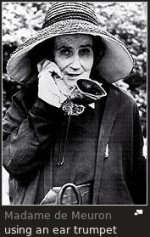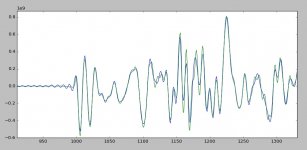Warning, "rant" ahead:
You mind if I'm saying that your criteria is unreliable and hence cannot be extended to others? Did anybody around debated your experience with cymbals?
It is VERY reliable to learn how accurate your system sounds.
maybe you were blinded with rage and did not see the other quotes cut/past of the drummer who said his cymbals sounded blurred on CD. Any one can compare and the musician can often tell you what you dont know about the sound.
THx-RNMarsh
You've done pseudo objective comparison of live vs recorded voice (mid range) but you've claimed CD not being accurate as it gets close to 20KHz. How did that come about?YOu have to do that test your self. He heard his instruments and the repo. he can tell you if it sounded the same. But it was not played off a file burned to CD in some CD player electronics. Some sounded same to him and some didnt
But, yes, that is the process, basically that i use to tell how good your system is. I suggest a voice of someone you are very familiar with... mid range. First as the recording will be at its best. then graduate to piano (if you have one) or cymbal.
You've done pseudo objective comparison of live vs recorded voice (mid range) comparison but you've claimed CD not being accurate as it gets close to 20KHz. How did that come about?
Sort of dense HF content. Just use a cymbal then. maybe one with the many little buttons all around it, too.
THx-RNMarsh

Last edited:
Maybe blinded with rage? he's trying to make it an art form.maybe you were blinded with rage and did not see the other quotes cut/past of the drummer who said his cymbals sounded blurred on CD. Any one can compare and the musician can often tell you what you dont know about the sound.
THx-RNMarsh
I am confident that I would not be able to tell the difference between the files. Personally, I would ask a professional drummer.
jn
Last edited:
You're right, that's the only way to get close because it would require juggling with the mic position to get it to sound similar.YOu have to do that test your self.
You've compared the sound of cymbal live vs recorded & replayed with CD?Sort of dense HF content. Just use a cymbal then. maybe one with the many little buttons all around it, too.
maybe you were blinded with rage
Yes, lots of this rage:
(...)
Do not go gentle into that good night.
Rage, rage against the dying of the light.
Attachments
Last edited:
, I would ask a professional drummer.
jn
And he'd say 'eh, speak up' 😛
Do you listen near field or far field? Do you have low distortion speakers? Do you listen to a Lot of live music instruments?
-RNM
My speakers are 3m apart and I was listening at 3m and also at 4m distance from my electrostatic speakers.
I and my family listens a lot to live music, with a grandfather once being concertmaster of the Concertgebouw A’dam and lots of sisters and cousins playing professionally harp and violin.
Hans
That is IT. That is all this comes down to. the rest is almost interesting and would not exist if back in the day, the standards were set higher...
THx-RNMarsh
It was then.
In the mid-seventies, I said to an Ampex guy: "16 bit is not enough, I want 24 bit". He laughed and said: "I'd love to sell you a 24 bit converter, it'll be about that size." and pointed to a full 19" rack.
And so 16 bit was cast in stone, and the dark age begun.
You've compared the sound of cymbal live vs recorded & replayed with CD?
Yes.
But you can do file only first and compare to burned CD and then higher sampling etc to see what sounds more like realistic. Check out lots of ways.
Then you know something about your repo system and about files size. I surely expect some to not hear changes on their repo system. Thats fine. It doesnt bother me.
I would tend to design for that one person who hears the difference (maybe a musician?) to be sure No One could hear a difference, either. Not to some middle ground of popular acceptance.
But, thats just me.
Thx-RNMarsh
Last edited:
My speakers are 3m apart and I was listening at 3m and also at 4m distance from my electrostatic speakers.
I and my family listens a lot to live music, with a grandfather once being concertmaster of the Concertgebouw A’dam and lots of sisters and cousins playing professionally harp and violin.
Hans
And does your repo system sound as accurate as live compared with CD with music playing?
If so, you are done. Enjoy. If not, does 24/192 sound closer to reality?
THx-RNMarsh
Last edited:
It is here that we need some love, that we miss so much in this forum ?T, how can your ears be attached to Matt's head?
YouTube
The only non audio listening thing I could think of is a point by point comparison of the analog output for full rate and after the filter. I bet the subtraction and it's spectra would be interesting, it could be looked at to see what audible content was removed by the brickwall.
jn
Here's a picture of the attack green original blue with removal of everything over 22050. The Gibbs is seen at the new fs/2, the subtraction is done on a full 10sec clip at once (1,920,000 points) so the separation of the spectra shows only the numerical noise floor (~-250dB). The horizontal scale is in samples (5.2us) the vertical scale is arbitrary, I had to convert the 24bit into 32bit (Python does not do odd bytes) and then process at 64bit FP no loss of resolution or truncation happened AFAIK.
Attachments
Last edited:
And does "the circle of confusion" ring any distant bells?And does your repo system sound as accurate as live compared with CD?
We don't choose our mics in studio to get a perfect reproduction of the instruments, but to try to enlighten what we prefer in their character.
Anyway, it is not a question of response curves, but "affinity". We all have noticed, in the Ethan Winer video how some instruments sound similar, and others no, with the same mic.
YouTube
Anyway, it is not a question of response curves, but "affinity". We all have noticed, in the Ethan Winer video how some instruments sound similar, and others no, with the same mic.
YouTube
Last edited:
Here's a picture of the attack green original blue with removal of everything over 22050. The Gibbs is seen at the new fs/2, the subtraction is done on a full 10sec clip at once (1,920,000 points) so the separation of the spectra shows only the numerical noise floor (~-250dB).
That is so cool, thanks.
What does the difference look like in the same time period?
Odd the spectra difference is minimum 250db down,yet the differences are clearly there. I see places where the green is almost 20% higher peak than the blue, with the same basic waveform.
Without knowing the details of a cymbal, it looks like the first three cycles are the stick impact, and after a slight pause, the entire disk (disc?) enters the fray. I would assume related to the surface wave velocity in brass(?).
An FEA of the entire cymbal would be neat to see done to show propagation and overall response of the surface movement, but that's just the geek in me.
jn
Last edited:
- Status
- Not open for further replies.
- Home
- Member Areas
- The Lounge
- John Curl's Blowtorch preamplifier part III

